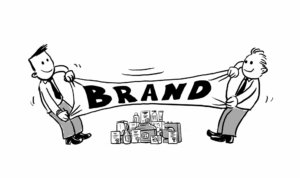Marketing is a great profession and the marketing 5Ps is the code by which we live. I’ve worked in or with marketing teams for almost my whole career and I am passionate about brand building.
From the outside, others see marketers as those who come to work late and seem to party all night. They always seem to be watching TV or jetting off to exotic places to talk about advertising!
For people working in operations or finance, marketers just don’t seem to be doing a very serious job; they’re always having too much fun! I’m sure you’ve already heard such comments.
Well, as you yourself know, marketing IS fun, but it’s also a lot of hard work, often close to 24/7 on some occasions.
So does all that hard work pay off? Not often enough in my opinion. And why? Because marketers simply don’t always ask the right questions!
The 5 Questions Marketers Should Ask
If you work in marketing, you already know the 5Ps – people, place, product, price and promotion. However, the problem with those is that when you find an issue with one of them, you know the “what” but not the “how”.
So I suggest you work with my 7Qs instead. Each of my seven questions explain not only what to check, but also the how and why you need to examine the area.
And if you can’t immediately answer more than just a couple of them, then perhaps you need to do a little more work and a little less partying!
Q1. Who are your customers?
 The first “P” stands for people and often this is taken to be “Do you know to whom you are selling?” The answer is always yes and that’s accepted as sufficient.
The first “P” stands for people and often this is taken to be “Do you know to whom you are selling?” The answer is always yes and that’s accepted as sufficient.
Instead, ask yourself who your customers really are. I don’t mean just their demographics, but what, where and how they use or consume your brand and the category in which you are competing. And especially the why of their attitudes and behaviours. If you can’t give all these details about your customers, then you’re in serious trouble.
For more on this topic, see “12 things you need to know about your target customers” for details on better defining your customer persona. You will also find a link in the article to download a useful template you can use to store all your information as you gather it.
Q2. How are your customers changing?
Hopefully, you answered Q1 without any hesitation – you did, didn’t you? Did you also download our template and complete it? Many of my clients find it a useful way to store and rapidly access the information whenever they need it.
It’s great that you know a lot about your customers, but people change. Are you following how your customers are changing? Are you keeping up with them and their new opinions, needs and desires?
Do you know the impact of the latest societal trends and new technologies on your customers’ behaviours? Do you know how these changes may alter your market in five, ten or even twenty years from now?
There are countless examples of brands that have disappeared because they didn’t keep up with the changing needs of their customers:
- Kodak who didn’t understand the impact of digital photography.
- Borders bookstores who didn’t get into eBooks.
- Motorola, once the leader in smartphones, who didn’t embrace new communications technology.
- Sony who resisted MP3 and lost the portable music player market that they had led for years.
- Blockbuster who survived the transition from VHS to DVD, but failed to adapt to consumers’ demand for home delivery.
Don’t be another one on the list. The current coronavirus outbreak is clearly demonstrating that we can never be too prepared for the unthinkable, because it might just happen!
The easiest way to be ready for any future changes is to prepare for them, by developing future scenarios in advance.
How many possible future societal and customer changes have you already prepared for? If you would like help in this area, we and our partners offer both standard and ground-breaking new ways to develop scenarios using science-fiction writers. Contact us for more details.
Q3. What does your brand stand for?
 I don’t mean it’s marketing identity or slogan; I mean how your customers or your competitors’ customers would describe it?
I don’t mean it’s marketing identity or slogan; I mean how your customers or your competitors’ customers would describe it?
Is it strong and consistent? Does it align precisely with its identity or the positioning you want today? Do you follow the developments in its image regularly?
Do you adapt your advertising and promotions to strengthen its desired image and eliminate negative changes before they impact your brand’s identity? Is it authenticated by your customers’ experiences with your brand? It should be a direct reflection of your brand’s (internal) identity and promise.
You should be able to describe your brand in one or at most a couple of sentences, using the words and ideas you want it to stand for, like these:
- Hero Group’s mission is “to delight consumers by conserving the goodness of nature.”
- McDonalds offers “quick, convenient, family-oriented and fun, casual dining.”
- Bic disposable pens, lighters and razors offer “high-quality products at affordable prices, convenient to purchase and convenient to use.”
- Dollar Shave Club: “Shave and grooming made simple.”
What you notice about all these examples is that they clearly define the benefit to the customer and what the brand is promising to provide.
There is a synergy between what the internal image of the brand is and what the customers would say about each. When that is achieved, you have a strong brand that your customers relate to and to which they are more likely to remain loyal.
How would you describe your brand in one short sentence? I’ll be happy to provide feedback in a short call if you’d like to share it. Just contact me to set up a time.
Q4. How are sales and distribution?
I am not referring to just the totals, I mean the local specificities. The regional differences and anomalies. Do you know why they occur? Do these differences result from cultural differences, alternative traditions or usage, historical reasons or just distributor practices?
Even if you work in marketing and not sales, understanding your brand’s weekly, monthly and annual sales trends, means you will gain an increased understanding of your customers and their differences.
If you don’t know why your brand is doing better in some regions than others, then you’re probably missing opportunities for growth. Always play to your strengths and correct your weaknesses as soon as they are identified.
Q5. Do you know what your brand is worth?
I don’t mean how much it costs to manufacture and distribute. I mean how it is valued by the end user. How does your brand’s value compare to its current price? Incorrect pricing could mean that you are leaving money on the table!
If you are priced lower than your customers’ perceived value of it, you could be asking for more. If you are priced above the perceived value of your potential customers’, you are stopping many new customers from buying into your offer, as they may not think you’re worth it. This results in your having to offer frequent promotions and price-offs just to keep your sales stable.
If this is your situation, it is certainly time to get a true evaluation of your offer by your customers. I can help if you’re not sure how to do this.
Whether you are over or under-priced, you could be earning more and possibly selling more too. Don’t stay ignorant to your true customer value.
Q6. Are you using the right communication channels?
 Many marketing plans are still just a rehash of last year’s, especially when it comes to advertising and promotions.
Many marketing plans are still just a rehash of last year’s, especially when it comes to advertising and promotions.
With today’s huge array of media opportunities, both on and offline, it is important to choose the most appropriate ones for your customers.
If you answered Q1 completely, then you know which ones they are currently using most often. In particular, it is important to understand their social media behaviour, as this can vary widely by customer segment.
In addition, if you are also able to answer Q2 you will know how usage is likely to change in the future. This will give you ample time to adjust your plans and move seamlessly from offline to online when necessary.
Wasting money with outdated media plans, based on channels your customers no longer use, is still one of the biggest errors of marketing, even in this data-rich environment in which we live today. Make sure it’s not yours.
For a fun piece on the topic, check out “
Q7. Is your messaging consistent and complementary?
Answering Q3 means that you know what you want to stand for and the image you want to portray. Image metrics will tell you which of them need to be boosted, depending upon any desired changes you need to make.
Do you want to attract new customers, support current customers, or develop your image in a certain direction? Appropriate analysis of your brand image data will give you all the information you need to adapt your messaging and strengthen the positioning you have chosen for it.
If you want to better understand how to develop brand image in relation to brand personalities and archetypes, then “What you need to know about Brand Image, Personality & Archetypes” is a great place to start.
And for more details on brand building in general, or brand image analysis in particular, check out the relevant sections in my book “Winning Customer Centricity: Putting Customers at the Heart of Your Business – One Day at a Time.”
It’s been called “A must read for today’s and tomorrow’s marketeers” by none other than Paul Pohlman, Unilever’s former CEO! Why not follow many major Fortune 500 CPG companies and get your own copy, or buy copies for your whole team?
So there you have them, the seven questions that I believe will bring you greater results than just using the traditional marketing 5Ps. What do you think?
Next time you review your brand’s performance, why not give the 7Qs a try? They will provide you with a clearer picture of your brand’s current and future development opportunities, and more importantly, will identify the actions you need to take to progress its growth. Then leave a comment below on how useful you found this new way of looking at your brand.

Is it time to review your own 5Ps?
Let C3Centricity support you with a fast-acting catalyst session or even better, a 1-Day training for your whole team.
Find out more and download the Training Summaries HERE.
Did you enjoy this post and all its tips, tools and ideas? If so, then why not share it with your colleagues and peers?











